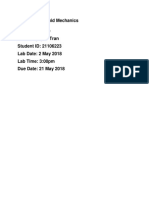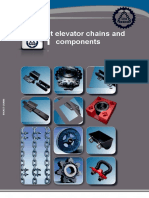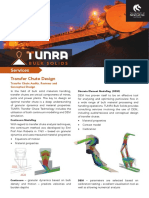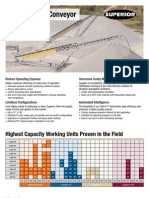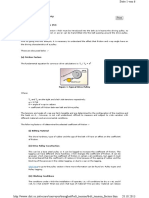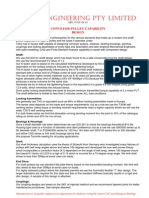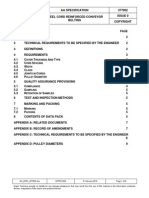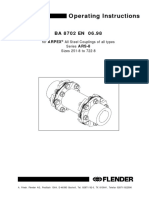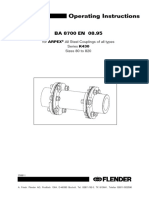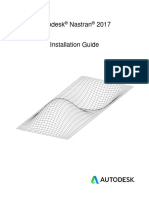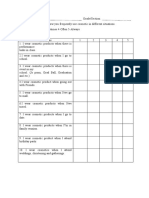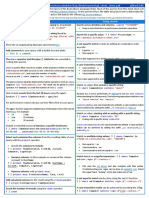Coefficient of Friction PDF
Coefficient of Friction PDF
Uploaded by
Waris La Joi WakatobiCopyright:
Available Formats
Coefficient of Friction PDF
Coefficient of Friction PDF
Uploaded by
Waris La Joi WakatobiOriginal Title
Copyright
Available Formats
Share this document
Did you find this document useful?
Is this content inappropriate?
Copyright:
Available Formats
Coefficient of Friction PDF
Coefficient of Friction PDF
Uploaded by
Waris La Joi WakatobiCopyright:
Available Formats
Rockfield Technologies
Australia Pty. Ltd.
TECHNICAL REPORT
MEASUREMENT OF BULK COAL SLIDING
FRICTION ON VARIOUS WEAR PLATE
PRODUCTS
FOR
ALLOY STEEL INTERNATIONAL PTY LTD
Technical Letter: Measurement of Bulk Coal Sliding Friction on Various Wear
Plate Products
Distribution: Alloy Steel International Pty Ltd
Limitation Statement
The sole purpose of this technical report and the services performed by Rockfield Technologies
Australia Pty Ltd (RTA) was to experimentally measure the frictional forces acting between lightly
consolidated bulk coal samples and wear plate samples.
No warranty, or guarantee, whether expressed or implied, is made with respect to data not directly
measured during this investigation, or to the observations and conclusions expressed as a result of
that data.
The report has been prepared on behalf of and for the exclusive use of Alloy Steel International Pty
Ltd. RTA accepts no liability or responsibility whatsoever for or in respect of any use or reliance upon
this report by any third party.
Rockfield Technologies Australia Pty Ltd COMMERCIAL-IN-CONFIDENCE
Executive Summary
Rockfield Technologies Australia Pty Ltd was contracted by Alloy Steel International Pty Ltd to
experimentally measure the effective coefficient of sliding friction between bulk coal and four wear
plate samples. The primary purpose of the experimentation was to determine the frictional
performance of the Alloy Steel ARCOPLATE ARCO ALLOY 1600, in both as supplied (pre-polished)
and worn conditions. The worn ARCOPLATE ARCO ALLOY 1600 sample was taken from an
excavator bucket post-excavation of 61 Million BCM of overburden and coal. Two alternative
commercially available wear plate products (Utility Stainless steel - ASTM A240 UNS S41003 and
400HB Q&T Steel Plate) were also tested for comparison and benchmarking of the ARCOPLATE
ARCO ALLOY 1600 results.
A purpose-designed test cell (shown on the cover of this report) was designed and commissioned for
operation with a conventional Jenike Shear cell test bed, located at the School of Engineering at
James Cook University, Queensland, Australia.
A medium-volatile, bituminous coking coal from Gregory Mine in Queensland’s Bowen basin was used
for the testing. The moisture content of the coal samples used in each test was determined in
accordance with Australian Standards. Coal moisture content was consistent throughout the testing
program and ranged between 7.0% and 7.5% by mass.
The Alloy Steel ARCOPLATE ARCO ALLOY 1600 performed very well with respect to the alternative
products tested. In the as-supplied, pre-polished condition, the ARCOPLATE ARCO ALLOY 1600
exhibited 23% less frictional resistance than the Utility Stainless Steel - ASTM A240 UNS S41003. In
the worn condition, the ARCO ALLOY 1600 exhibited 39% less frictional resistance than the Utility
Stainless Steel - ASTM A240 UNS S41003.
There was little discernable difference between the measured frictional resistance of the Utility
Stainless Steel - ASTM A240 UNS S41003 and the 400HB Q&T Steel Plate. This is due to the similar
surface finish of the two products in their as-supplied condition.
Rockfield Technologies Australia Pty Ltd COMMERCIAL-IN-CONFIDENCE
Introduction
Alloy Steel International Pty Ltd manufactures ARCOPLATE ARCO ALLOY 1600, a Chromium Carbide
Overlay Plate product that possesses very high resistance to abrasive wear [1]. The ARCOPLATE
product is widely employed throughout the mining and mineral processing industries as a result of this
key performance feature.
The ARCOPLATE product has also developed an industry reputation for reducing ‘hang up’ or ‘carry
back’ of low flowability materials, due most likely to low frictional resistance properties of the high
Chromium ARCO ALLOY 1600. Furthermore, observations have been widely made that this anti-hang
up performance is further enhanced as the ARCOPLATE wears during service.
To quantify the frictional performance of the ARCOPLATE ARCO ALLOY 1600, Alloy Steel
International Pty Ltd contracted Rockfield Technologies Australia Pty Ltd to conduct sliding friction
experiments to determine the frictional performance of the ARCOPLATE ARCO ALLOY 1600 in as
supplied and worn conditions, and compare this performance with measurements taken using two
alternative commercially available wear plate products (Utility Stainless steel - ASTM A240 UNS
S41003 and 400HB Q&T).
With Australian Coal exports tipping $25 Billion in the 2006/07 financial year, the potential for adoption
of the ARCOPLATE advanced wear and anti-hang up lining material within this sector of the mining
industry is enormous. As such, Alloy Steel International requested that coal be used as the candidate
bulk solid for the testing program.
Experimental Apparatus
A purpose-built test cell was designed and commissioned for the testing program. Both the test cell
and accompanying measurement system was developed for use with an existing Jenike test bed
located at the School of Engineering at James Cook University. Shown in Figure 1, the apparatus
allows for a coal sample volume of 1.7 litres to be consolidated to an appropriate level against the wear
plate surface being tested for frictional performance. The carriage (to which the candidate wear plate
sample is fastened) is subsequently driven at constant speed by the geared motor on the Jenike test
bed and the frictional resistance at the wear surface is directly measured and recorded via load cells.
The carriage displacement and sample consolidation are also recorded during each experiment [2].
Coal Type
A medium-volatile, bituminous coking coal from Gregory Mine in Queensland’s Bowen basin was made
available by James Cook University for the testing program. Due to the size of the test cell, the coal
earmarked for testing was sieved at 3/8 inch (9.53mm) to remove the larger particles before preparing
samples of the coal for testing (i.e. mixing and moisture addition).
Rockfield Technologies Australia Pty Ltd COMMERCIAL-IN-CONFIDENCE
Figure 1 Sliding friction test apparatus
Experimental Procedures
The following key procedures were developed and adopted for the sliding friction experiments, and
have been based on Australian Standards methods for soils testing [3]:
1. Preparation of coal samples [4].
2. Sliding friction test procedure [2].
3. Measuring coal sample moisture content [5].
Rockfield Technologies Australia Pty Ltd COMMERCIAL-IN-CONFIDENCE
Experimental Program
Tests were conducted for each of the four wear plate samples, at two different levels of consolidating
load, providing a core set of eight experiments. A further four experiments were conducted as
replicates to ensure repeatability in the test results.
Results
Table 1 contains coefficient of sliding friction and corresponding sliding friction angle results for the
eight core experiments. Table 2 contains corresponding coal sample moisture content results.
Table 3 contains coefficient of sliding friction results for repetition tests conducted for three randomly
selected core experiments.
Table 1 Coefficient of sliding friction and corresponding sliding friction angle results
Friction Coefficient [-] Sliding Friction Angle [Degrees]
Wall Pressure 1 Wall Pressure 2 Wall Pressure 1 Wall Pressure 2
Material Type
(9.35 kPa) (13.1 kPa) (9.35 kPa) (13.1 kPa)
Pre-Polished
ARCOPLATE
0.33 0.34 18.3 18.6
Worn ARCOPLATE
(Excavator bucket 0.26 0.27 14.7 15.0
- 61 Million BCM)
Utility Stainless Steel
ASTM A240 UNS S41003
0.44 0.43 23.6 23.3
400HB Q&T Steel Plate
(Brand 1)
0.43 0.44 23.0 23.0
Rockfield Technologies Australia Pty Ltd COMMERCIAL-IN-CONFIDENCE
Table 2 Coal sample average moisture content results
Coal Sample Moisture Content [%]
Wall Pressure 1 Wall Pressure 2
Material Type
(9.35 kPa) (13.1 kPa)
Pre-Polished
ARCOPLATE
7.2 7.2
Worn ARCOPLATE
(Excavator bucket 7.0 7.3
- 61 Million BCM)
Utility Stainless Steel
ASTM A240 UNS S41003
7.3 7.3
400HB Q&T Steel Plate
(Brand 1)
7.5 7.3
Table 3 Sliding friction angle results for repetition tests
Sliding Friction Angle [degrees]
Wall Pressure
Material Type
[ kPa]
Core Test Repetition 1 Repetition 2
Worn ARCOPLATE
(Excavator bucket 9.35 14.7 14.7 -
- 61 Million BCM)
Utility Stainless Steel
ASTM A240 UNS S41003
13.1 23.3 23.6 23.7
400HB Q&T Steel Plate
(Brand 1)
13.1 23.6 23.4 -
From the bulk coal sliding friction test results presented in Tables 1 – 3, the following observations are
made regarding the validity of the testing procedures:
• The purpose-built testing apparatus was successful in measuring the frictional resistance to
bulk coal sliding on various wear plate surfaces.
• A high level of repeatability of the test results was also shown for three randomly selected test
conditions.
• The moisture content results for the coal test samples showed a satisfactory level of
consistency throughout the testing program.
Rockfield Technologies Australia Pty Ltd COMMERCIAL-IN-CONFIDENCE
Conclusions
The following conclusions are made regarding the measured bulk coal frictional performance of the
various wear plate products tested:
• In the as-supplied, pre-polished condition, the ARCO ALLOY 1600 exhibited 23% less frictional
resistance than the Utility Stainless Steel - ASTM A240 UNS S41003.
• In the worn condition, the ARCO ALLOY 1600 exhibited even greater performance, exhibiting
39% less frictional resistance than the Utility Stainless Steel - ASTM A240 UNS S41003.
• In the as-supplied, mill-finish condition, there was little discernable difference between the
frictional performance of the Utility Stainless Steel - ASTM A240 UNS S41003 and the 400HB
Q&T Plate.
References
1. National Research Council Canada, Controlled Technical Report No. IFCI-MWMR-CTR-43,
2006.
2. AS1289.2.1.1-1998. Methods of testing soils for engineering purposes; Method 6.2.2 - Soil
strength and consolidation tests—Determination of the shear strength of a soil—Direct shear
test using a shear box.
3. AS1289.0-2000. Methods of testing soils for engineering purposes – General requirements
and list of methods.
4. AS1289.1.1-2001. Methods of testing soils for engineering purposes; Method 1.1 – Sampling
and preparation of soils – Preparation of disturbed soil samples for testing.
5. AS1289.2.1.1-2001. Methods of testing soils for engineering purposes; Method 2.1.1 - Soil
moisture content tests—Determination of the moisture content of a soil—Oven drying method
(standard method).
Rockfield Technologies Australia Pty Ltd COMMERCIAL-IN-CONFIDENCE
You might also like
- Ensc3003 Lab 2Document2 pagesEnsc3003 Lab 2Bi BinNo ratings yet
- CES Wrong Answer Summary-1Document2 pagesCES Wrong Answer Summary-1Владислав Комаров100% (2)
- Arcoplate TecnologiaPresentationDocument75 pagesArcoplate TecnologiaPresentationrinaldo KurniawanNo ratings yet
- Sidewall Splicing MechanicalDocument11 pagesSidewall Splicing MechanicalTamer EmamNo ratings yet
- Drive Chains PDFDocument347 pagesDrive Chains PDFzalabi100% (1)
- S-Wall™ Sidewall Conveyor Belting: Technical ManualDocument44 pagesS-Wall™ Sidewall Conveyor Belting: Technical ManualVasant HiremathNo ratings yet
- D-Bucket ChainsDocument45 pagesD-Bucket ChainsMuhammad Irvan FNo ratings yet
- Shrink Disc TAS SchaeferDocument20 pagesShrink Disc TAS SchaeferFernando Tapia GibsonNo ratings yet
- Soportes Take UP STL Series - Rodamientos SmilovicDocument4 pagesSoportes Take UP STL Series - Rodamientos SmilovicAlejandro SmilovicNo ratings yet
- TUNRA Bulk Solids Transfer ChuteDocument2 pagesTUNRA Bulk Solids Transfer ChuteBin ChenNo ratings yet
- Vertical Screw Elevators PDFDocument10 pagesVertical Screw Elevators PDFtamil vaananNo ratings yet
- Classification of Applications For Bulk Material Conveyor Belt CleaningDocument9 pagesClassification of Applications For Bulk Material Conveyor Belt CleaningadereNo ratings yet
- Kule 03-04 Arası KonveyorDocument34 pagesKule 03-04 Arası KonveyorHasan arif KısaalioğluNo ratings yet
- WT8586-Flexowell enDocument8 pagesWT8586-Flexowell enpmf engineering limitedNo ratings yet
- TeleStacker® ConveyorDocument4 pagesTeleStacker® ConveyorSuperior IndustriesNo ratings yet
- General Kinematics - UncoalerDocument38 pagesGeneral Kinematics - UncoalerJogesh NarulaNo ratings yet
- Dynamic Design of Belt Conveyors: Diploma ThesisDocument256 pagesDynamic Design of Belt Conveyors: Diploma ThesisSanchai_SaNo ratings yet
- Bulk Carriers Cement, Fly AshDocument4 pagesBulk Carriers Cement, Fly AshPeter Marcellus EpeNo ratings yet
- Sempertrans Splicing Instruction 2000 Ep 800 & 1600Document9 pagesSempertrans Splicing Instruction 2000 Ep 800 & 1600aziz ttlNo ratings yet
- Beckley - Transition Geometry - BSH - 1982!04!012Document5 pagesBeckley - Transition Geometry - BSH - 1982!04!012Emerson Ferreira100% (1)
- Belt Tension TheoryDocument6 pagesBelt Tension TheoryPedro ViegasNo ratings yet
- Ash Conveying SystemsDocument1 pageAsh Conveying SystemsTrishul Nath PallayNo ratings yet
- DesignDocument4 pagesDesignJigneshkumar PatelNo ratings yet
- IPSS IdlersDocument23 pagesIPSS IdlersHarish KumarNo ratings yet
- AF Apron Feeder: Key BenefitsDocument2 pagesAF Apron Feeder: Key BenefitsIle JieNo ratings yet
- Is 8531 1986Document6 pagesIs 8531 1986Srini KumarNo ratings yet
- Lorbrand CleanscrapeDocument3 pagesLorbrand CleanscrapeMarcus GregórioNo ratings yet
- Conveying and StoringDocument28 pagesConveying and StoringTin Nguyen100% (1)
- On-Line Manual: Vibrator SelectionDocument6 pagesOn-Line Manual: Vibrator Selectiongk_kishoree81No ratings yet
- Factors Affecting Selection of Gravity Separators For CoalDocument2 pagesFactors Affecting Selection of Gravity Separators For CoalJai Prakash Patel100% (1)
- Allgaier Apt Tro Dryingtechnologiesformineralrawmaterials enDocument12 pagesAllgaier Apt Tro Dryingtechnologiesformineralrawmaterials enesteNo ratings yet
- Suspension Gear PaperDocument27 pagesSuspension Gear PaperSteve PennNo ratings yet
- MAT 2011 MCGB - Data Sheet For Suppliers Old MAT No.: 142Document3 pagesMAT 2011 MCGB - Data Sheet For Suppliers Old MAT No.: 142deepak kumarNo ratings yet
- Dosing Solutions - Rotary Airlock Feeder Blow Through - Palamatic ProcessDocument4 pagesDosing Solutions - Rotary Airlock Feeder Blow Through - Palamatic Processxxx0% (1)
- Conveyor Idlers PDFDocument10 pagesConveyor Idlers PDFDhirendraRaviNo ratings yet
- Experiment No. 1 Muller Mixer: AIM TheoryDocument2 pagesExperiment No. 1 Muller Mixer: AIM TheoryDhananjay ShimpiNo ratings yet
- ZISCO Installs World LongestDocument11 pagesZISCO Installs World LongestJoshua GrahitaNo ratings yet
- Ramsey Conveyor Protection SwitchesDocument6 pagesRamsey Conveyor Protection SwitchesArif AmirNo ratings yet
- Is 4776 1 1977Document12 pagesIs 4776 1 1977retrospect1000No ratings yet
- Aa Spec 377002Document9 pagesAa Spec 377002jonodo89No ratings yet
- Performance of Conveyor Stringers - Deflection LimitDocument8 pagesPerformance of Conveyor Stringers - Deflection Limiteep1977No ratings yet
- Roller Bearing Supported Mills FINAL LRDocument8 pagesRoller Bearing Supported Mills FINAL LRHiresomannavar MahanteshNo ratings yet
- Calculation of Artificial Friction Conveying Coefficient F, and A Comparison Between ISO and CEMADocument9 pagesCalculation of Artificial Friction Conveying Coefficient F, and A Comparison Between ISO and CEMAretrospect1000No ratings yet
- Rotary Valves ZRSDocument7 pagesRotary Valves ZRSkosmcNo ratings yet
- Almex SVP Brochure 106Document4 pagesAlmex SVP Brochure 106Enrique GutierrezNo ratings yet
- AHR Brochure PDFDocument6 pagesAHR Brochure PDFjraulpdNo ratings yet
- Gate ValvesDocument2 pagesGate Valves@sss0% (1)
- Unloading Systems For Self Unloading Cement CarriersDocument17 pagesUnloading Systems For Self Unloading Cement CarriersGourav DubeyNo ratings yet
- Belt Feeder Properly DesignedDocument2 pagesBelt Feeder Properly DesignedCarlos Ediver Arias Restrepo100% (1)
- Iso 3684 1990Document8 pagesIso 3684 1990joaquin fuentealba moralesNo ratings yet
- Almex Conveyor Belt Training Manual (Glossary of Terms Section)Document27 pagesAlmex Conveyor Belt Training Manual (Glossary of Terms Section)Luis FloresNo ratings yet
- Telestack Tracked Conveyors BrochureDocument4 pagesTelestack Tracked Conveyors BrochureRaghavendra DeshpandeNo ratings yet
- CV 01 Shaft Report Drive P5Document2 pagesCV 01 Shaft Report Drive P5Waris La Joi WakatobiNo ratings yet
- FABA CATALOGUE Bucket Elevator PDFDocument23 pagesFABA CATALOGUE Bucket Elevator PDFahmerkhateeb100% (1)
- Screens - TemaDocument16 pagesScreens - TemaCherezade Karine Saud SotoNo ratings yet
- Technical offer for wagon tippler 5 december 2024revDocument33 pagesTechnical offer for wagon tippler 5 december 2024revsunilkumar100% (1)
- OreFlow Australia BrochureDocument14 pagesOreFlow Australia BrochureshanhardNo ratings yet
- Phoenix Steel CordDocument32 pagesPhoenix Steel Cordtechlibrary072023No ratings yet
- Salt Spray ChamberDocument6 pagesSalt Spray Chamberazize hosseinjanyNo ratings yet
- Fitness For Service Evaluations and Repair of Ammonia Storage Sphere After 25 Years of ServiceDocument9 pagesFitness For Service Evaluations and Repair of Ammonia Storage Sphere After 25 Years of Servicealimirpur100% (1)
- Evaluation of The Stress Corrosion Cracking Behaviour of Damage-Tolerant A1-Li Sheet Using The Slow Strain Rate Testing TechniqueDocument12 pagesEvaluation of The Stress Corrosion Cracking Behaviour of Damage-Tolerant A1-Li Sheet Using The Slow Strain Rate Testing TechniqueSchmetterling TraurigNo ratings yet
- 8702en PDFDocument32 pages8702en PDFWaris La Joi WakatobiNo ratings yet
- Technical Data Hino 700 ProfiaDocument5 pagesTechnical Data Hino 700 ProfiaWaris La Joi WakatobiNo ratings yet
- Operating Instructions: BA G298 EN 08.98Document39 pagesOperating Instructions: BA G298 EN 08.98Waris La Joi WakatobiNo ratings yet
- Pulley Weight Calc PDFDocument9 pagesPulley Weight Calc PDFWaris La Joi WakatobiNo ratings yet
- Calc - Vibrating Screen Single Deck NPK1Document5 pagesCalc - Vibrating Screen Single Deck NPK1Waris La Joi Wakatobi100% (1)
- Feeder Breaker Chain (Renold Chain) Double Pitch Sprocket DesignDocument1 pageFeeder Breaker Chain (Renold Chain) Double Pitch Sprocket DesignWaris La Joi Wakatobi0% (1)
- 8703en PDFDocument35 pages8703en PDFWaris La Joi WakatobiNo ratings yet
- 7300en PDFDocument9 pages7300en PDFWaris La Joi WakatobiNo ratings yet
- RUPEX Coupling RWNDocument26 pagesRUPEX Coupling RWNWaris La Joi WakatobiNo ratings yet
- PARAMAX NEW Copy Rev2Document281 pagesPARAMAX NEW Copy Rev2Waris La Joi WakatobiNo ratings yet
- 7300en PDFDocument9 pages7300en PDFWaris La Joi Wakatobi100% (1)
- Operating Instructions: BA K295 EN 06.97Document45 pagesOperating Instructions: BA K295 EN 06.97Waris La Joi WakatobiNo ratings yet
- ZAPEX CouplingDocument22 pagesZAPEX CouplingWaris La Joi Wakatobi100% (1)
- AlldocumentsDocument8 pagesAlldocumentsWaris La Joi WakatobiNo ratings yet
- Arpex CouplingDocument38 pagesArpex CouplingWaris La Joi WakatobiNo ratings yet
- Wire Rope Drum HoistDocument3 pagesWire Rope Drum HoistWaris La Joi WakatobiNo ratings yet
- Analisis Drag Scrapper Chain Feeder (FB01 & FB02) EPIDocument10 pagesAnalisis Drag Scrapper Chain Feeder (FB01 & FB02) EPIWaris La Joi WakatobiNo ratings yet
- Survey of Cargo Handling ResearchDocument95 pagesSurvey of Cargo Handling ResearchWaris La Joi WakatobiNo ratings yet
- Trailing Chasis Axle R1Document62 pagesTrailing Chasis Axle R1Waris La Joi WakatobiNo ratings yet
- Installation GuideDocument15 pagesInstallation GuideWaris La Joi WakatobiNo ratings yet
- Vertical Curve Radius Calculations: Pt. Vortex IndonesiaDocument4 pagesVertical Curve Radius Calculations: Pt. Vortex IndonesiaWaris La Joi WakatobiNo ratings yet
- Boogie TelestackerDocument1 pageBoogie TelestackerWaris La Joi WakatobiNo ratings yet
- Shaft Component Generator For Boogie StackerDocument6 pagesShaft Component Generator For Boogie StackerWaris La Joi WakatobiNo ratings yet
- List Mining CompanyDocument12 pagesList Mining CompanyWaris La Joi WakatobiNo ratings yet
- Handbook of Hydraulics For The Solution of Hydraulic Engineering ProblemsDocument7 pagesHandbook of Hydraulics For The Solution of Hydraulic Engineering ProblemsKhaled MahranNo ratings yet
- ĐỀ SỐ 9Document4 pagesĐỀ SỐ 9Đào Hoài AnNo ratings yet
- Morelos Escuelas en Operacion Al 3 de NoviembreDocument138 pagesMorelos Escuelas en Operacion Al 3 de NoviembreEris MiNo ratings yet
- Structure of BacteriaDocument15 pagesStructure of BacteriaAva EbsNo ratings yet
- Section 2: Systems of Linear EquationsDocument10 pagesSection 2: Systems of Linear EquationsDidula ThrimannaNo ratings yet
- Helical Spring RevisedDocument5 pagesHelical Spring RevisedJubaer RabbyNo ratings yet
- MIS Group AssignmentDocument2 pagesMIS Group AssignmentHodo Abdilahi100% (1)
- Temperature Effects On The Tensile Properties of CastDocument38 pagesTemperature Effects On The Tensile Properties of CastDACAMOGO DCMGNo ratings yet
- Grandma's Bible: A Short StoryDocument5 pagesGrandma's Bible: A Short StoryTonyNo ratings yet
- Memoire Faila OkDocument79 pagesMemoire Faila Okleabahati925No ratings yet
- Mark Check On How You Frequently Use Cosmetic in Different SituationsDocument3 pagesMark Check On How You Frequently Use Cosmetic in Different Situationsjames alfon villocinoNo ratings yet
- ECA2plus Tests Language Test 7ADocument2 pagesECA2plus Tests Language Test 7AMaciek BryńczakNo ratings yet
- Bisalloy's PlatesDocument16 pagesBisalloy's PlatesMarcoNo ratings yet
- Gad 2019Document10 pagesGad 2019Rica Mae TingcoNo ratings yet
- Formula One Race Car Technologies and MaintenanceDocument2 pagesFormula One Race Car Technologies and MaintenancePhotonsmart DxNo ratings yet
- Ishta Devata How To Find Ishtadevata ?Document2 pagesIshta Devata How To Find Ishtadevata ?tmn2011No ratings yet
- Diamond-Backlight-Helmet-Full FeasibilityDocument83 pagesDiamond-Backlight-Helmet-Full Feasibilityborrezvia024No ratings yet
- Customer Satisfaction Towards Dainik BhaskarDocument10 pagesCustomer Satisfaction Towards Dainik BhaskarkharemixNo ratings yet
- EVA DegradationDocument6 pagesEVA Degradationivan dodurovNo ratings yet
- Project Shakti and CSRDocument2 pagesProject Shakti and CSRAmit kumarNo ratings yet
- Millet Seminal and Technical - ShefaliDocument1 pageMillet Seminal and Technical - ShefaliShristi ShefaliNo ratings yet
- Generic String Search: KQL DocumentationDocument2 pagesGeneric String Search: KQL DocumentationKobiNo ratings yet
- Pomodoro TechniceDocument12 pagesPomodoro TechniceDiploma AlbNo ratings yet
- 44-1-75LB 2U AU EN safetyDataSheet Sds 8799831064580 0 1Document11 pages44-1-75LB 2U AU EN safetyDataSheet Sds 8799831064580 0 1compras.lairtechNo ratings yet
- ActionresearchfinalDocument27 pagesActionresearchfinalapi-302202934No ratings yet
- 2023 Lunzuran Latest Gad Accomplishment ReportDocument10 pages2023 Lunzuran Latest Gad Accomplishment ReportMely Delacruz100% (3)
- Best Quiet Dehumidifier For Basement Apartment - DeyeDocument4 pagesBest Quiet Dehumidifier For Basement Apartment - DeyeMtek Solar energyNo ratings yet
- Cyber SecurityDocument32 pagesCyber SecurityKamardeep KumarNo ratings yet
- Automotive AerodynamicDocument105 pagesAutomotive AerodynamicDevansh SrivastavaNo ratings yet
